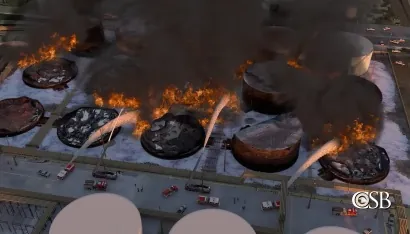
Unveiling the Truth: The $150 Million Fire Disaster at ITC
2025-09-15
Author: Mei
A Fiery Catastrophe Unveiled
In a shocking incident that rocked Deer Park, Texas, a major fire at the Intercontinental Terminals Company (ITC) facility burned for an astounding three days, causing over $150 million in damages. The U.S. Chemical Safety and Hazard Investigation Board (CSB) has just released a detailed safety video, "Terminal Failure: Fire at ITC," offering a gripping animation of the event along with insights from CSB Chairperson Steve Owens and Investigator-In-Charge Crystal Thomas.
What Went Wrong?
On March 17, 2019, disaster struck when a circulation pump on Tank 80-8 failed catastrophically, allowing a highly flammable mix of butane and naphtha to spill onto the ground. Alarmingly, the leak went unnoticed for thirty minutes before igniting, triggering a massive explosion and fire. The damage was extensive: 15 tanks were destroyed, and the local community faced multiple shelter-in-place orders due to the escalating crisis.
A Toxic Nightmare
The repercussions of the fire extended beyond immediate property loss. A breach in the containment wall led to an environmental disaster, releasing an estimated 470,000-523,000 barrels of toxic hydrocarbons and contaminated water into a nearby bayou, eventually making its way to the Houston Ship Channel. The contamination prompted the closure of a seven-mile stretch of the channel and several waterfront parks, tarnishing the local ecosystem.
System Failures Revealed
In the video, Chairperson Owens reveals major lapses in safety protocols, emphasizing that ITC lacked critical monitoring systems to alert staff of the pump failure and had no remotely operated emergency isolation valves to stop the spill. The design of the tank farm also put other tanks at risk, making it impossible to avert the catastrophic fire once the incident began.
Key Takeaways from the CSB Report
The CSB's exhaustive investigation highlighted five crucial safety issues that contributed to this disaster: pump mechanical integrity, flammable gas detection systems, emergency isolation protocols, and the overarching design of the tank farm. The report also outlines important safety recommendations directed at ITC, the American Petroleum Institute, OSHA, and the EPA.
Pushing for Change
Chairperson Owens reinforces that a significant gap in federal regulations exacerbated the situation, advocating for expanded oversight on chemicals and facilities. He urges that implementing the CSB’s recommendations is vital to preventing similar tragedies in the future.
As the community grapples with the aftermath of this disaster, the lessons learned may shape the future of chemical safety regulations, ensuring such a devastating incident never happens again.


 Brasil (PT)
Brasil (PT)
 Canada (EN)
Canada (EN)
 Chile (ES)
Chile (ES)
 Česko (CS)
Česko (CS)
 대한민국 (KO)
대한민국 (KO)
 España (ES)
España (ES)
 France (FR)
France (FR)
 Hong Kong (EN)
Hong Kong (EN)
 Italia (IT)
Italia (IT)
 日本 (JA)
日本 (JA)
 Magyarország (HU)
Magyarország (HU)
 Norge (NO)
Norge (NO)
 Polska (PL)
Polska (PL)
 Schweiz (DE)
Schweiz (DE)
 Singapore (EN)
Singapore (EN)
 Sverige (SV)
Sverige (SV)
 Suomi (FI)
Suomi (FI)
 Türkiye (TR)
Türkiye (TR)
 الإمارات العربية المتحدة (AR)
الإمارات العربية المتحدة (AR)